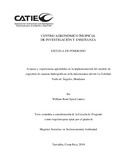| dc.contributor.author | Speer Laínez, William R. | |
| dc.date.accessioned | 2014-10-20T04:01:35Z | |
| dc.date.available | 2014-10-20T04:01:35Z | |
| dc.date.issued | 2010 | es_ES |
| dc.identifier | 374942 | es_ES |
| dc.identifier.uri | https://repositorio.catie.ac.cr/handle/11554/4409 | |
| dc.identifier.uri | http://orton.catie.ac.cr/repdoc/A5385e/A5385e.pdf | es_ES |
| dc.description | Tesis (M. Sc) -- CATIE, Turrialba (Costa Rica), 2010 | es_ES |
| dc.description.abstract | gobernanza, gobernabilidad e institucionalidad gestión territorial del agua mecanismos de financiamiento y escalamiento territorial. Se utilizaron diferentes metodologías entre ellas: entrevistas semi-estructuradas, consultas con informantes claves, revisión de estudios y publicaciones realizadas en el área de estudio. Los resultados obtenidos indican un aceptable grado de avance en el componente de la planificación y el monitoreo, en la planificación operativa, además de la adecuada aplicación de indicadores de monitoreo como la calidad de agua, avanzando hacia otros aspectos biofísicos y socioeconómicos. Este proyecto de investigación tuvo como objetivo analizar los principales avances y experiencias aprendidas en la implementación del modelo de cogestión de cuencas hidrográficas implementado por CATIE en la microcuenca del río La Soledad, en el municipio de Valle de à ngeles, Honduras. El análisis se realizó con base a los cinco componentes principales del modelo de cogestión de cuencas hidrográficas, siendo estos: planificación y monitoreo The objective of this thesis was to comprehend the main advances and lessons learned in the five co-managed watershed components, which are: monitoring and planning, governance and institucionality, territorial water management, financial aid mechanism and territorial scaling up, applied by CATIE, in the upper portion of La Soledad River in Valle de Angeles County, Honduras. The methodologies used for research were: polls, key actors interview, analyze and study of printed issues and publications in the area. After all the data was analyzed, a proposal was written, that will help strengthen the FOCUENCAS program in the area. After the implementation of these five co-managed watershed components, the new tools and methologies that have been discovered add key advances in the planning methods, supervising the quality and quantity of water for human consumption, and the other biophysical and social economical aspects that have been the monitoring process main achievements. | es_ES |
| dc.language.iso | es | es_ES |
| dc.publisher | CATIE, Turrialba (Costa Rica) | es_ES |
| dc.subject | HONDURAS | |
| dc.subject | CUENCAS HIDROGRAFICAS | |
| dc.subject | ORDENACION DE CUENCAS | |
| dc.subject | ORDENACION DE AGUAS | |
| dc.subject | PARTICIPACION COMUNITARIA | |
| dc.subject | PARTICIPACION SOCIAL | |
| dc.subject | PLANIFICACION | |
| dc.subject | GOBERNANCIA | |
| dc.subject | ORDENACION TERRITORIAL | |
| dc.subject | FINANCIAMIENTO | |
| dc.title | Advances and lessons learned in co-managed watershed components applied at the upper portion of La Soledad River, at Valle de Angeles County, Honduras | es_ES |
| dc.title.alternative | Avances y experiencias aprendidas en la implementación del modelo de cogestión de cuencas hidrográficas en la microcuenca del río La Soledad, Valle de à ngeles, Honduras | es_ES |
| dc.type | Tesis de maestría | es_ES |
| dcterms.rights | acceso abierto | |
| dc.identifier.publication | Turrialba (Costa Rica) | es_ES |


